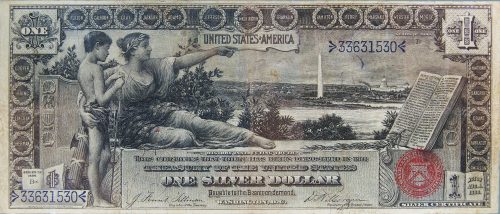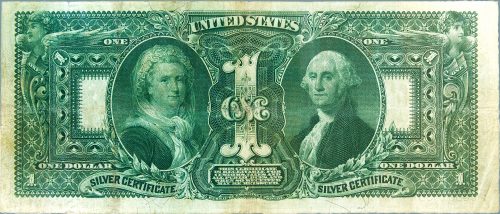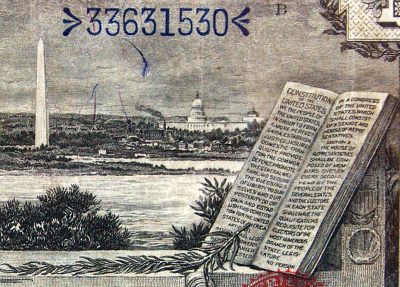P033
Large Bill, Very Fine (obvious fold lines; a lot of fiber in the paper)
189 mm (7-3/8”), 78 mm (3-1/8”)
HISTORY: In 1894, Claude M. Johnson (1852‒1919), Director of the Bureau of Engraving and Printing from 1893 to 1900, ordered the creation of a new currency design, which set into motion the production of $1, $2, and $5 silver certificates. These became known, popularly by collectors, as the “Educational Series.” Artist and muralist Will Hicok Low (1853‒1932) was commissioned on May 10, 1894, to design the obverse of the $1 certificate. Two months later (July 10, 1894), his design was completed and accepted. Thomas F. Morris (1852‒1898), designer of the reverse, redesigned the obverse borders and lettering before the certificates were finally released on April 18, 1896. Charles Schlecht (1843–?), commissioned for this project, was a talented engraver of both stamps and banknotes who had joined the American Bank Note Company (ABNC) in 1859.
OBVERSE: Low, a painter and muralist, brought his panoramic skills to bear in creating this lofty scene. Reclining on a marble parapet above the Potomac River in Virginia is a laurel-wreathed Minerva (or Greek counterpart Athena), the Roman goddess of wisdom, art, strategy, and commerce. Wrapped in a skirt of stars, her right arm embraces a young scholar, a fasces leaning behind his legs, her left arm directing attention toward a distant landscape of the late 19th century Washington, DC. The 555-foot tall Washington Monument obelisk had been completed only six years earlier, becoming an important landmark. The Capitol building lies a mile to the east with the domed Library of Congress behind. Between, with smoke curling into the sky from its chimney stack, is the Smithsonian Castle.
On the parapet to the right leans the opening pages of the Constitution of the United States, a sprig of rosemary (known by ancient Greeks as anthos, ἄνθος, meaning “flower”) rests against its first page.
The perimeter is adorned with the last names of 23 leaders of American history, each framed within laurel wreaths, beginning at the lower left.
- Henry Wadsworth Longfellow (1807‒1882): poet, educator
- William T. Sherman (1820‒1891): U.S. Army commanding general
- Abraham Lincoln (1809‒1865): statesman, 16th president
- Washington Irving (1783‒1859): writer, biographer, historian
- James Fenimore Cooper (1789‒1851): writer
- Robert Fulton (1765‒1815): engineer, inventor
- John C. Calhoun (1782‒1850): statesman, 7th vice president
- Henry Clay (1777‒1852): statesman, 9th secretary of state, Kentucky senator
- Andrew Jackson (1767‒1845): U.S. Army general, congressman, 7th president
- John Adams, Jr. (1735‒1826): statesman, attorney, founding father, 2nd president
- Thomas Jefferson (1743‒1826): statesman, diplomat, architect, founding father, 3rd president
- George Washington (1732‒1799): Continental Army general, statesman, founding father, 1st president
- Benjamin Franklin (1706‒1790): scientist, inventor, writer, statesman, diplomat, founding father
- Alexander Hamilton (1755‒1804): statesman, lawyer, legal scholar, economist, founder of U.S. financial system, founding father
- Matthew C. Perry (1794‒1858): commodore of U.S. Navy
- John Marshall (1755‒1835): lawyer, 4th chief justice of the U.S. Supreme Court
- Noah Webster (1758‒1843): lexicographer, editor, author
- Samuel Morse (1791‒1843): painter, inventor
- Nathaniel Hawthorne (1804‒1864): novelist
- George Bancroft (1800‒1891): historian, statesman, secretary of U.S. Navy, established Naval Academy at Annapolis (1845)
- Ulysses S. Grant (1822‒1885): U.S. Army general, 18th president
- David Farragut (1801‒1870): U.S. Navy admiral
- Ralph Waldo Emerson (1803‒1882): essayist, philosopher, poet
REVERSE: This intricate, elaborate greenback, designed by Morris and engraved by Schlecht, also included the George Washington portrait by engraver Alfred Sealey and the Martha Washington portrait by master engraver Charles Kennedy Burt (1823‒1892). Burt spent 16 years with the ABNC before taking the position of principal engraver for the Bureau of Engraving & Printing. Controversy arose over the oversized “1,” separating husband and wife, yet it remained so throughout the several years this silver certificate was in circulation. In the upper-right and upper-left corners are two beautifully engraved seraphim, each with flowered wreaths.



